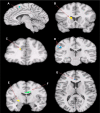Sleep is associated with task-negative brain activity in fibromyalgia participants with comorbid chronic insomnia
- PMID: 26648751
- PMCID: PMC4648619
- DOI: 10.2147/JPR.S87501
Sleep is associated with task-negative brain activity in fibromyalgia participants with comorbid chronic insomnia
Abstract
Patients with chronic pain exhibit altered default mode network (DMN) activity. This preliminary project questioned whether comorbid disease states are associated with further brain alterations. Thirteen women with fibromyalgia (FM) only and 26 women with fibromyalgia with comorbid chronic insomnia (FMI) underwent a single night of ambulatory polysomnography and completed a sleep diary each morning for 14 days prior to performing a neuroimaging protocol. Novel imaging analyses were utilized to identify regions associated with significantly disordered sleep that were more active in task-negative periods than task-oriented periods in participants with FMI, when compared to participants with FM. It was hypothesized that core DMN areas (ie, cingulate cortex, inferior parietal lobule, medial prefrontal cortex, medial temporal cortex, precuneus) would exhibit increased activity during task-negative periods. Analyses revealed that significantly disordered sleep significantly contributed to group differences in the right cingulate gyrus, left lentiform nucleus, left anterior cingulate, left superior gyrus, medial frontal gyrus, right caudate, and the left inferior parietal lobules. Results suggest that FMI may alter some brain areas of the DMN, above and beyond FM. However, future work will need to investigate these results further by controlling for chronic insomnia only before conclusions can be made regarding the effect of FMI comorbidity on the DMN.
Keywords: brain activity; comorbidity; fibromyalgia; insomnia; neuroimaging; task-negative.
Figures

References
-
- Zysset S, Huber O, Ferstl E, von Cramon DY. The anterior frontomedian cortex and evaluative judgment: an fMRI study. Neuroimage. 2002;15(4):983–991. - PubMed
Grants and funding
LinkOut - more resources
Full Text Sources

